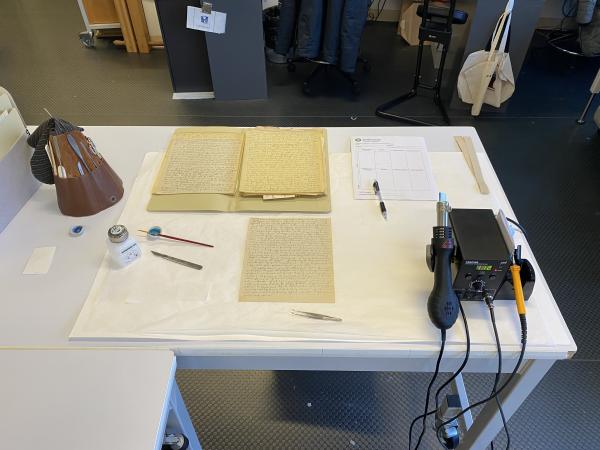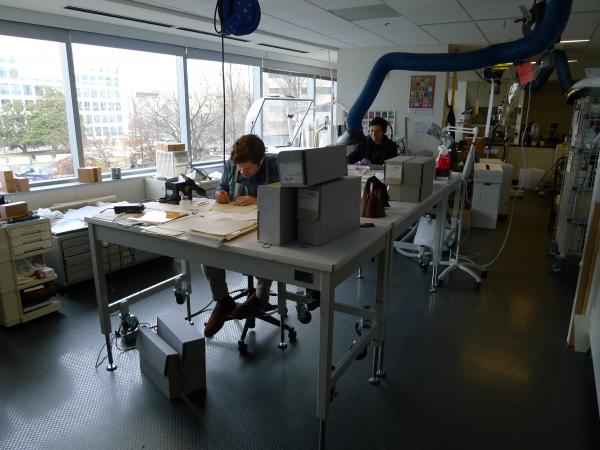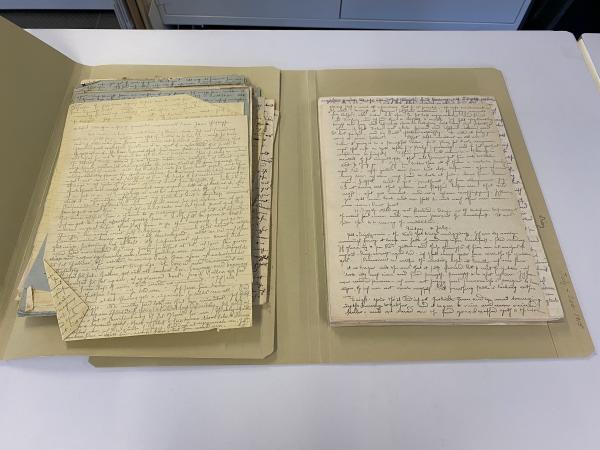Many of the conservation treatments we highlight on the blog focus on single items that require in-depth interventions—rebinding a disbound book, removing tape from an entire journal, mounting art on paper to new backing boards—but much of the work we do in the Archives is smaller in scope when it comes to the level of intervention … and much larger in scope when it comes to scale.
As part of a grant-funded digitization project, the Preservation Team has been reviewing and treating collections, specifically diaries, from Record Unit 7310, Smithsonian entomologist Doris Holmes Blake’s papers. These are fascinating items. She wrote on whatever she could get her hands on, from purpose-bought journals to backs of inventory forms, and for privacy, she wrote in German black letter script to make them harder to read. The varied nature of the paper she used provides some of the challenge in this project, because each leaf of paper presents different needs and therefore requires different treatments.

The other factor in choosing our treatment is time. Our grant-funded projects often have hard deadlines associated with them, and the sheer volume of diary pages that need attention dwarf the amount of person power we have available to devote even a fraction of an hour each document. Instead, we have chosen quick and effective treatment methods to speed the process (while still maintaining ethical and professional standards).

We chose to use heat-set tissue to make our repairs—thin Japanese papers coated with heat-activated acrylic adhesive. They are quick to apply, and because they don’t introduce moisture, don’t have the potential to distort any of the often fragile, poor-quality papers Blake wrote on in her diaries. The thinness of the tissue also keeps the text legible in cases where the mends must be made over written areas. Most importantly, with the application of more heat to soften the acrylic adhesive, the repair can be reversed. In cases where tears have overlapping edges, we use methyl cellulose as an adhesive before applying a heat-set mend, and to release folds or creases, a dilute alcohol solution is applied before allowing it to dry flat under moderate weight.

Every item we treat is unique and requires its own thoughtful intervention, but the demands and realities of a working archive also play a role in the decision-making process. Access and preservation must be balanced continually, and this treatment solution allows timely preparation of the materials for digitization while providing a solution that meets the needs of the collection items as well.
Related Resources
- “Doris Holmes Blake and Her Natural History,” by Tatiana Swann, The Bigger Picture, Smithsonian Institution Archives
- “A Tale of Three Contracts,” by William Bennett, The Bigger Picture, Smithsonian Institution Archives
- “Navigating Treatment of the Dawson Map,” by William Bennett, The Bigger Picture, Smithsonian Institution Archives
- “Rafinesque, Ready for a Close-Up,” by William Bennett, The Bigger Picture, Smithsonian Institution Archives
Produced by the Smithsonian Institution Archives. For copyright questions, please see the Terms of Use.

Leave a Comment